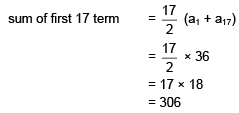Q.1. Five numbers are in A.P., whose sum is 25 and product is 2520. If one of these five numbers is -1/2, then the greatest number amongst them is (2020)
(1) 27
(2) 7
(3) 21/2
(4) 16
Ans. (4)
Solution. Let the five terms of A.P. be a - 2d, a - d, a, a + d and a + 2d.
Therefore,
a - 2d + a - d + a + a + d + a + 2d = 25
⇒ 5a = 25 ⇒ a = 5
Now, (a - 2d)(a - d)a(a + d)(a + 2d) = 2520
⇒ (a2 - 4d2) (a2 - d2) = 504
⇒ (25 - 4d2)(25 - d2) = 504
⇒ 4d2 - 125d2 + 121 = 0
Now, none of the term of A.P. is -1/2 by using d = ±1. So, d = ± 11/2
So, the terms of A.P. are -6, -1/2, 5, 21/2 and 16. Hence, the greatest term among them is 16.
Q.2. Let a1, a2, a3,… be a G.P. such that a1 < 0, a1 + a2 = 4 and a3 + a4 = 16. If  then λ is equal to (2020)
then λ is equal to (2020)
(1) -513
(2) -171
(3) 171
(4) 511/3
Ans. (2)
Solution. Let the common ratio of G.P. be r, then
a1 + a2 = 4 ⇒ a1 + a1r = 4
⇒ a1(1 + r) = 4 ...(1)
And
a3 + a4 = 16 ⇒ a1r2 + a1r3 = 16
⇒ a1r2(r+1) = 16 ...(2)
From Eqs. (1) and (2), we get
r2 = 4 ⇒ r = -2 (since a1 < 0)
Now,
a1 + a2 = 4 ⇒ a1(1 + r) = 4 ⇒ a1 = -4
Therefore,


Q.3. If a, b and c be three distinct real numbers in G.P. and a + b + c = xb, then x cannot be: (2019)
(1) -2
(2) -3
(3) 4
(4) 2
Ans. (4)
Solution.
∵ a, b, c, are in G.P.
Take square on both sides, we get
∵ a2 + c2 is positive and b2 = ac which is also positive.
Then, x2 - 2x - 1 would be positive but for x = 2, x2 - 2x - 1 is negative.
Hence, x cannot be taken as 2.
Q.4. Let a1, a2, ..... a30 be an 
If a5 = 27 and S - 2T = 75, then a10 is equal to: (2019)
(1) 52
(2) 57
(3) 47
(4) 42
Ans. (1)
Solution. 
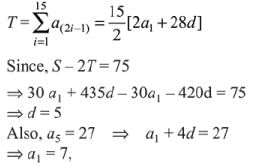
Hence, a10 = a1 + 9d = 7 + 9 x 5 = 52
Q.5. The sum of the following series 
 up to 15 terms, is: (2019)
up to 15 terms, is: (2019)
(1) 7520
(2) 7510
(3) 7830
(4) 7820
Ans. (4)
Solution.

Now, nth term of the series,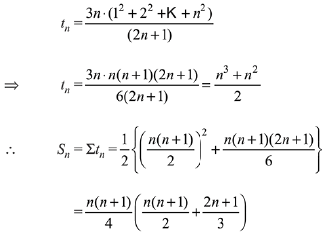
Hence, sum of the series up to 15 terms is,

= 7200 + 620
= 7820
Q.6. Let a, b and c be the 7th, 11th and 13th terms respectively of a non-constant A.P. If these are also the three consecutive terms of a G.P., then a/c is equal to: (2019)
(1) 2
(2) 1/2
(3) 7/13
(4) 4
Ans. (4)
Solution. Let first term and common difference be A and D respectively.
∴ a = A + 6D, b = A+ 10D and c = A + 12D
Since, a, b, c are in G.P.
Hence, relation between a, b and c is,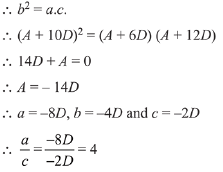
Q.7. Let a1, a2, a3, ..... a10 be in G.P. with ai > 0 for i = 1,2, .... 10 and S be the set of pairs (r,k), r,k ∈ N (the set of natural numbers) for which
Then the number of elements in S, is: (2019)
(1) 4
(2) infinitely many
(3) 2
(4) 10
Ans. (2)
Solution. Let common ratio of G.P. be R
C1→ C1-C2, C2→ C2-C3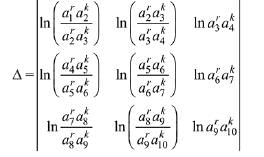
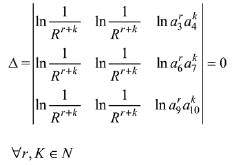
Hence, number of elements in S is infinitely many.
Q.8. The sum of an infinite geometric series with positive terms is 3 and the sum of the cubes of its terms is 27/19. Then the common ratio of this series is: (2019)
(1) 1/3
(2) 2/3
(3) 2/9
(4) 4/9
Ans. (2)
Solution. Let the terms of infinite series are a, ar, ar2, or3, ...
Since, sum of cubes of its terms is 27/19 that is sum of a3, a3r3....
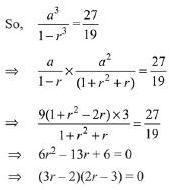

Q.9. Let a1, a2, ..., be a G.P. If  (2019)
(2019)
(1) 54
(2) 4(52)
(3) 53
(4) 2(52)
Ans. (1)
Solution. Let a1 = a, a2 = ar, a3 = ar2 ... a10 = ar9
where r= common ratio of given G.P.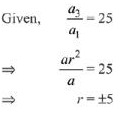
Now, 

Q.10. Let α and β be the roots of the quadratic equation x2 sinθ -x (sinθ cosθ + 1) + cosθ = 0 (0 < θ < 45°), and  is equal to: (2019)
is equal to: (2019)
(1) 
(2) 
(3) 
(4) 
Ans. (3)
Solution.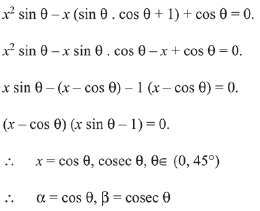
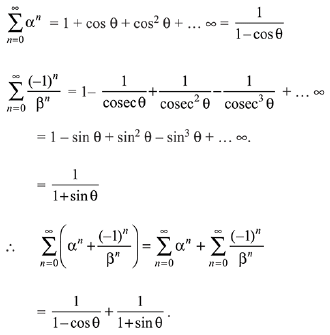
Q.11. If 19th term of a non-zero A.P. is zero, then its (49th term): (29th term) is: (2019)
(1) 4:1
(2) 1:3
(3) 3:1
(4) 2:1
Ans. (3)
Solution. Let first term and common difference of AP be a and d respectively, then
 ...(1)
...(1)
t49 : t29 = 3 : 1
Q.12. The product of three consecutive terms of a G.P. is 512. If 4 is added to each of the first and the second of these terms, the three terms now form an A.P. Then the sum of the original three terms of the given G.P. is: (2019)
(1) 36
(2) 32
(3) 24
(4) 28
Ans. (4)
Solution. Lets three terms of a G.P. be 

a3 = 512
a = 8
4 is added to each of the first and the second of three terms then three terms are,


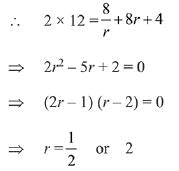
Therefore, sum of three terms 
Q.13.  Then A is equal to (2019)
Then A is equal to (2019)
(1) 283
(2) 301
(3) 303
(4) 156
Ans. (3)
Solution.

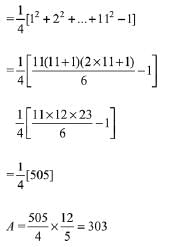
Q.14. If nC4, nC5 and nC6 are in A.P., then n can be: (2019)
(1) 9
(2) 14
(3) 11
(4) 12
Ans. (2)
Solution. Since nC4, nC5 and nC6 are in A.P.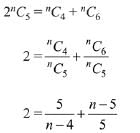
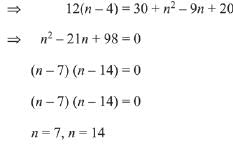
Q.15. If the sum of the first 15 terms of the series  is equal to 225 k then k is equal to: (2019)
is equal to 225 k then k is equal to: (2019)
(1) 108
(2) 27
(3) 54
(4) 9
Ans. (2)
Solution.

Let the general term of S be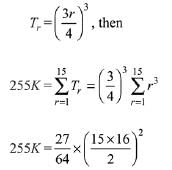
⇒ k = 27
Q.16. If three distinct numbers a, b, c are in G.P. and the equations ax2 + 2bx + c = 0 and dx2 + 2ex + f = 0 have a common root, then which one of the following statements is correct? (2019)
(1) 
(2) d, e, f are in A.P.
(3) d, e, f are in G.P.
(4) 
Ans. (1)
Solution. Since a, b, c are in G.P.
∴ b2 = ac
Given equation is, ax2 + 2bx + c = 0
Also, given that ax2 + 2bx + c = 0 and dx2 + 2ex + f = 0 have a common root.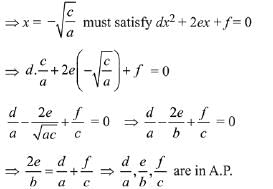
Q.17. The sum  is equal to: (2019)
is equal to: (2019)



Ans. (3)
Solution. 

On subtracting equations (ii) by (i),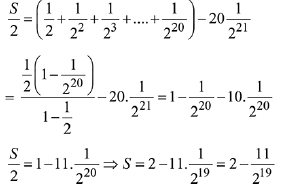
Q.18. Let the sum of the first n terms of a non-constant A.P., a1, a2, a3, ..... be 50n +  A, where A is a constant. If d is the common difference of this A.P., then the ordered pair (d, a50) is equal to: (2019)
A, where A is a constant. If d is the common difference of this A.P., then the ordered pair (d, a50) is equal to: (2019)
(1) (50.50 + 46A)
(2) (50, 50 + 45A)
(3) (A, 50 + 45A)
(4) (A, 50 + 46A)
Ans. (4)
Solution.



Q.19. If the sum and product of the first three terms in an A,P. are 33 and 1155, respectively, then a value of its 11th term is: (2019)
(1) -35
(2) 25
(3) -36
(4) -25
Ans. (4)
Solution. Let three terms of A.P. are a - d, a, a + d
Sum of terms is, a - d + a + a + d = 33 ⇒ a = 11
Product of terms is, (a - d)a(a + d)= 11(121 -d2)= 1155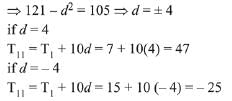
Q.20. The sum of the series 1+ 2 x 3+ 3 x 5 + 4 x 7 + ..... up to 11th term is: (2019)
(1) 915
(2) 946
(3) 945
(4) 916
Ans. (2)
Solution.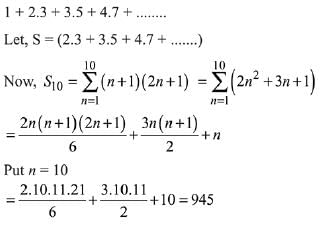
Hence required sum of the series = 1 + 945 = 946
Q.21. If a1, a2, a3, ... an are in A.P. and a1 + a4 + a7 + ....+ a16 = 114, then a1 + a6 + a11 + a16 is equal to: (2019)
(1) 98
(2) 76
(3) 38
(4) 64
Ans. (2)
Solution.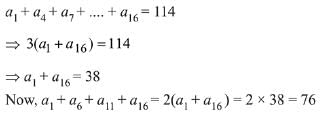
Q.22. The sum  up to 10th term, is: (2019)
up to 10th term, is: (2019)
(1) 680
(2) 600
(3) 660
(4) 620
Ans. (3)
Solution.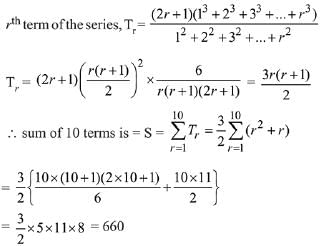
Q.23. The sum
 is equal to: (2019)
is equal to: (2019)
(1) 620
(2) 1240
(3) 1860
(4) 660
Ans. (1)
Solution.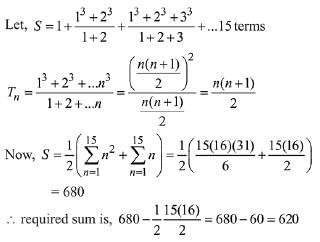
Q.24. Let a, b and c be in G.P. with common ratio r, where a≠ 0 and 0 < r≤ 1/2. If 3a, 7b and 15c are the first three terms of an A.P., then the 4th term of this A.P. is: (2019)
(1) 2/3a
(2) 5a
(3) 7/3a
(4) a
Ans. (4)
Solution. ∵ a, b, c are in G.P. ⇒ b = ar, c = ar2
∵ 3a, 7b, 15c are in A.P. ⇒ 3a, 7ar, 15ar2 are in A.P.
∴ 14ar = 3a + 15 ar2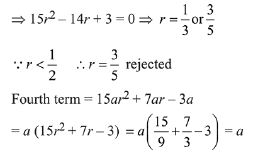
Q.25. For x ∈ R, let [x] denote the greatest integer ≤ x, then the sum of the series  (2019)
(2019)
(1) -153
(2) -133
(3) -131
(4) -135
Ans. (2)
Solution.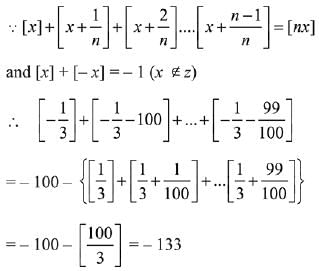
Q.26. If α and β are the roots of the equation 375x2-25x-2=0,  (2019)
(2019)
(1) 21/346
(2) 29/358
(3) 1/12
(4) 7/116
Ans. (3)
Solution.
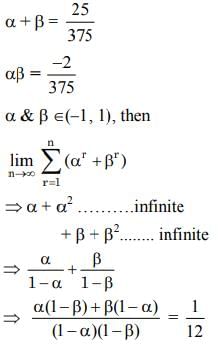
Q.27. Let Sn denote the sum of the first n terms of an A.P.
If S4 = 16 and S6 = -48, then S10 is equal to: (2019)
(1) -260
(2) -410
(3) -320
(4) -380
Ans. (3)
Solution.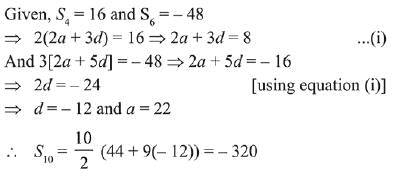
Q.28. If a1, a2, a3, .... are in A.P. such that a1 + a7 + a16 = 40, then the sum of the first 15 terms of this A.P. is: (2019)
(1) 200
(2) 280
(3) 120
(4) 150
Ans. (1)
Solution. Let the common difference of the A.P. is ‘d’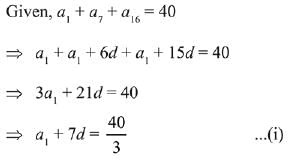
Now, sum of first 15 terms of this A.P. is,
Q.29. If α, β and γ are three consecutive terms of a non-constant G.P. such that the equations ax2+2βx+γ =0 and x2+x-1=0 have a common root, then α (β+γ) is equal to: (2019)
(1) 0
(2) αβ
(3) αγ
(4) βγ
Ans. (4)
Solution.
∵ α, β, γ are three consecutive terms of a non-constant G.P.
∴ β2 = αγ
So roots of the equation ax2 +2βx + γ = 0 are
∵ ax2 + 2βx + γ = 0 and x2 + x - 1 = 0 have a common root.
∴ this root satisfy the equation x2 + x - 1 = 0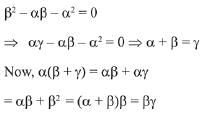
Q.30. Let a1 , a2 , a3 , ......, a49 be in A.P. such that  = 416 a9 + a43 = 66.
= 416 a9 + a43 = 66.
If a12 + a22 + .... + a172 = 140m then m is equal to: (2018)
(1) 66
(2) 68
(3) 34
(4) 33
Ans. (3)
Solution. a1 + a5 + a9 = 416 ⇒ a + 24d = 32 ......(i)
a9 + a43 = 66 ⇒ a + 25d = 33......(ii)
From (i) and (ii) d = 1 and a = 8
Q.31. If x1 , x2 …. , xn and 1/h1, 1/h2 ...... 1/hn are two A. P.s such that x3 = h2 = 8 and x8 = h7 = 20 , then x5 . h10 equals: (2018)
(1) 2650
(2) 2560
(3) 3200
(4) 1600
Ans. (2)
Solution. 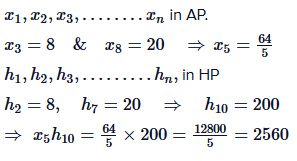
Q.32. If b is the first term of an infinite G.P. whose sum is five, then b lies in the interval: (2018)
(1) (0, 10)
(2) [10, ∞]
(3) (-10, 0)
(4) (-∞, -10]
Ans. (1)
Solution. If b is the first term and r is the common ratio of an infinite G.P. then sum is 5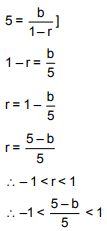
– 5 < 5 – b < 5
– 5 < 5 – b < 5
– 10 < – b < 0
0 < b < 10
b ∈ (0,10)
Q.33. Let 1/x1, 1/x2 ,..., 1/xn (xi ≠ 0 for i = 1, 2, & ., n) be in A.P. such that x1 = 4 and x21 = 20. If n is the least positive integer for which xn > 50, then  is equal to: (2018)
is equal to: (2018)
(1) 3
(2) 1/8
(3) 13/4
(4) 13/8
Ans. (3)
Solution.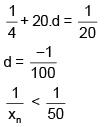
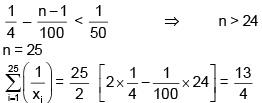
Q.34. The sum of the first 20 terms of the series  ..... is: (2018)
..... is: (2018)
(1) 
(2) 
(3) 
(4) 
Ans. (3)
Solution.
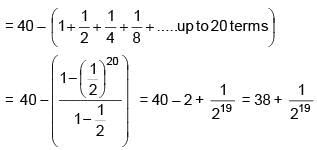
Q.35. For any three positive real numbers a, b and c, 9(25a2 +b2)+ 25(c2 - 3ac) = 15b(3a + c). Then (2017)
(1) a, b and c are in G.P
(2) b, c and a are in G.P
(3) b, c and a are in A.P
(4) a, b and c are in A.P
Ans. (3)
Solution. 9(25a2 + b2) + 25 (c2 - 3ac) = 15b (3a + c)
⇒ (15a)2 + (3b)2 + (5c)2 - 45ab - 15bc - 75ac = 0
⇒ (15a - 3b)2 + (3b - 5c)2 + (15a - 5c)2 = 0
It is possible when
15a - 3b = 0 and 3b - 5c = 0 and 15a - 5c= 0
15a = 3b= 5c
∴ b, c, a are in A.P.
Q.36. Let a, b, c ∈ R. If f(x) = ax2 + bx + c is such that a + b + c = 3 and  then
then  is equal to (2017)
is equal to (2017)
(1) 255
(2) 330
(3) 165
(4) 190
Ans. (2)
Solution. As, f (x + y)= f (x) + f (y) + xy
Given, f (1) = 3
Putting, x = y = 1 ⇒ f (2) = 2f (1)+ 1 = 7
Similarly, x = 1,y = 2 ⇒ f (3) = f (1) + f (2) + 2 = 12
= 3 + 7 + 12 + 18 + ... = S (let)
Now, S = 3 + 7 + 12 + 18 + ... +tn
Again, S = 3 +7 + 12 + ... +tn -1 + tn
We get, tn = 3 + 4 + 5 + ... terms




Q.37. If the arithmetic mean of two numbers and b,a, > b > 0. is five times their geometric mean, then  is equal to: (2017)
is equal to: (2017)



Ans. (4)
Solution.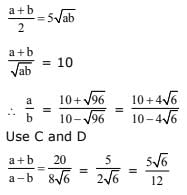
Q.38. If the sum of the first n terms of the series  then n equals: (2017)
then n equals: (2017)
(1) 13
(2) 15
(3) 29
(4) 18
Ans. (2)
Solution.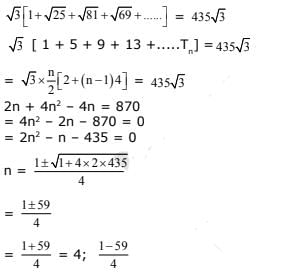
Q.39. If three positive numbers a, b and c are in A.P. such that abc = 8, then the minimum possible value of b is: (2017)
(1) 42/3
(2) 2
(3) 41/3
(4) 4
Ans. (2)
Solution.
For a set of positive numbers, the arithmetic mean is never smaller than the geometric mean. The geometric mean of the three numbers is 3 √ 8 = 2 . Since the numbers are in AP, their arithmetic mean is b . Thus the smallest possible value for b is 2 (this is achievable when all three numbers are 2 - an AP with zero common difference)
Q.40. Let then n is equal to: (2017)
(1) 200
(2) 199
(3) 99
(4) 19
Ans. (2)
Solution.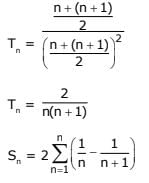
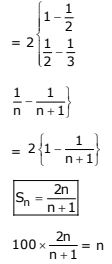
n + 1 = 200
n = 199
Q.41. If the sum of the first ten terms of the series m, then m is equal to: (2016)
m, then m is equal to: (2016)
(1) 102
(2) 101
(3) 100
(4) 99
Ans. (2)
Solution. upto 10 terms
upto 10 terms upto 10 terms.
upto 10 terms.
(8)2 + (12)2 + (16)2 + ……… up to 10 terms
Tn = [4 (n + 1)]2 where n varies from 1 to 10.
= 16(n2 + 2n + 1)
 upto 10 terms=
upto 10 terms= 
It is given that  = 16/5 m
= 16/5 m
∴ m = 505/5 = 101
Q.42. If the 2nd, 5th and 9th terms of a non-constant A.P. are in G.P., then the common ratio of this G.P. is: (2016)
(1) 8/5
(2) 4/3
(3) 1
(4) 7/4
Ans. (2)
Solution. t2 = a + d
t5 = a + 4d
t9 = a + 8d
Given t2, t5, t9 are in G.P.
(a + 4d)2 = (a + d) (a + 8d)
a2 + 16d2 + 8ad = a2 + 8d2 + 9ad
8d2 - ad = 0
d(8d - a) = 0
As given non-constant AP. => d ≠ 0
∴ d = a/8 => a = 8d
so, A.P. is 8d, 9d, 10d, …..
Common ratio of G.P. = 
Q.43. Let x, y, z be positive real numbers such that x + y + z = 12 and x3y4z5 = (0.1) (600)3. Then x3 + y3 + z3 is equal to (2016)
(1) 270
(2) 258
(3) 216
(4) 342
Ans. (3)
Solution. x + y + z = 12
x3y4 z5 = (0.1) (600)3 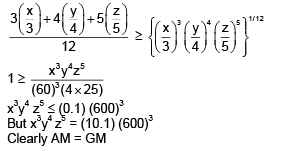

Q.44. The sum  is equal to (2016)
is equal to (2016)
(1) 10 × (11!)
(2) 101 × (10!)
(3) (11!)
(4) 11 × (11!)
Ans. (1)
Solution.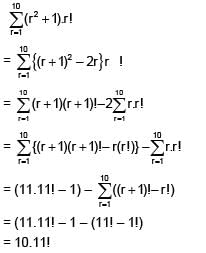
Q.45. Let a1, a2, a3,......., an ,.......be in A.P. If a3 + a7+ a11+ a15 = 72 then the sum of its first 17 terms is equal to (2016)
(1) 153
(2) 306
(3) 612
(4) 204
Ans. (2)
Solution. a1, a2, a3,......., an ,....... are in A.P.
a3 + a15 = a7 + a11 = a1 + a17 = 36